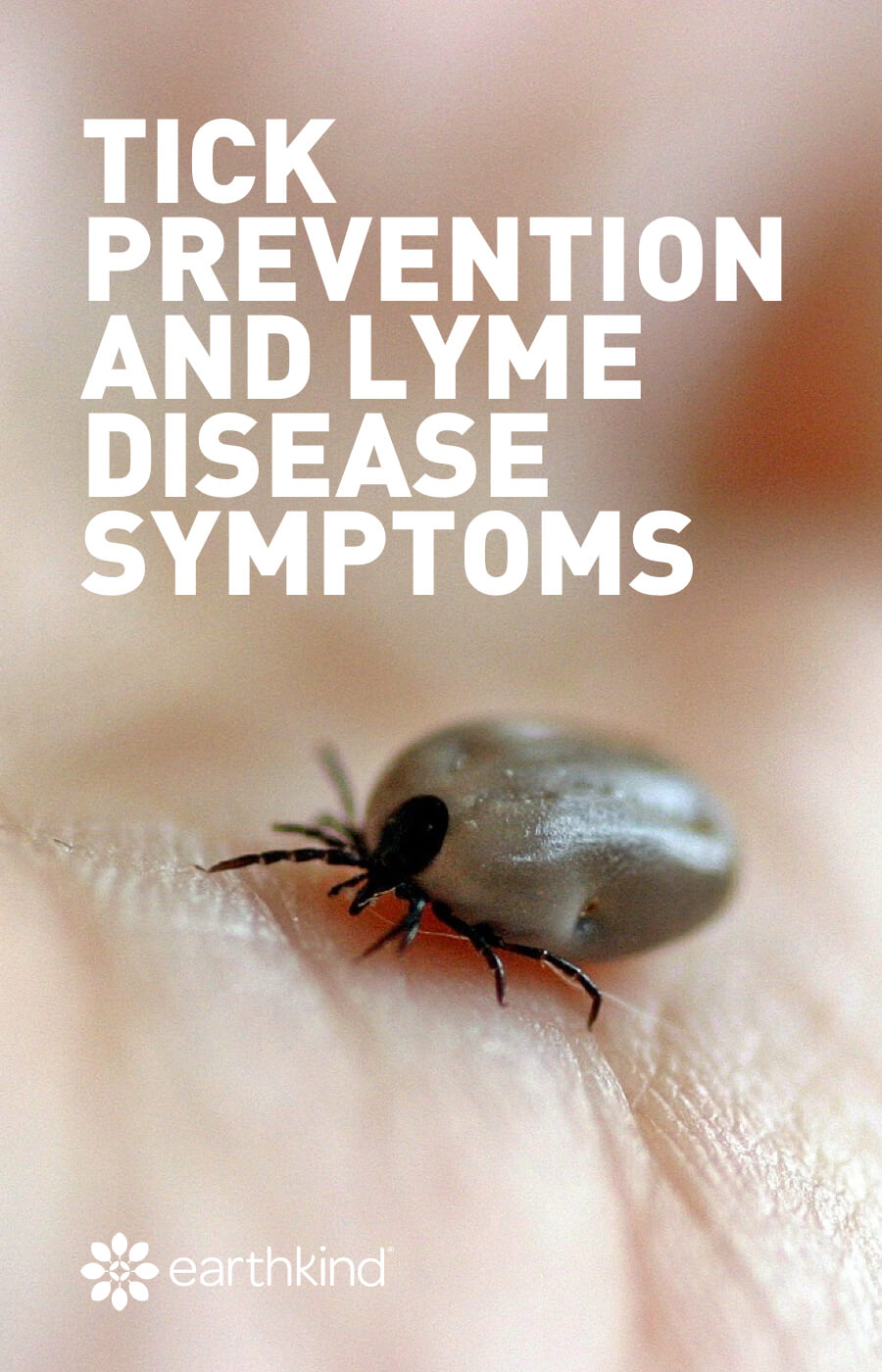How to Prevent Tick Bites & Avoid Lyme Disease
By: EarthKind
Tick prevention can be complicated. Ticks are sly, cunning little critters that are determined to wedge themselves inside the first warm-blooded host they cross paths with. If it sounds like they’re on the hunt for you, it’s because they are.
In all seriousness, ticks can be a real threat to humans and animals. They can transmit diseases, many of which can be fatal if not treated quickly.
And yet, these mobile disease-spreading forest dwellers do serve a purpose. Yes, even ticks play an important role in our ecosystem. Ticks are at the bottom of the food chain; animals like reptiles, amphibians, and birds rely on ticks for food. They are also very important components of our planet’s biodiversity, as they carry many different living microorganisms.
Since these pesky vermin aren’t going anywhere anytime soon, and we would like to leave the house to be in nature, we have a choice to make. We can either NEVER go into nature for fear of these pests, (sounds difficult but who needs fresh air and peace and quiet anyways?!) OR we can learn about what makes ticks, tick! By understanding them, we can learn to steer clear of them and more importantly keep them the heck away from us — Erm.. we mean peacefully coexist with them!
Tick Overview: Environment and Behavior
- Common hosts for Ticks: A tick requires a host for food and without one it cannot move onto the next stage of growth in its life cycle. The host can be an animal or a human depending on the species of tick.
- Where you’ll find them: These crafty bugs will sit and wait on tall grass, wooded areas, leaves, or branches while hoping for a host to brush up against them so they can latch onto clothing, skin, or hair. Once they’ve hitched a ride, they search for the optimal place to hunker down and start feeding.
- What attracts ticks to humans: These pests are very well equipped to sense an optimal host in advance so they can get ready to attach themselves when the time is right. They can detect a host’s breath, pick up on chemicals via sweat, and sense temperature changes as you approach them. This basically means human hosts are served up on a silver platter! And if that wasn’t enough evolutionary help, some species of ticks can even recognize shadows. So, before you harmlessly brush by some bushes on your next hike, just remember these plotting pests are eagerly anticipating this very move!
Fun fact: Ticks are attracted to ammonia and lactic acid. Ammonia is present in urine and lactic acid is a chemical produced in the body when you exercise. So, working up a sweat in the outdoors or peeing in the forest may attract ticks.
Dangers of Tick Bites
Some ticks can be dangerous to humans as they can transmit many diseases, including Lyme disease, which affects 30,000 Americans every year. Ticks infected with the bacteria borrelia burgdorferi transfer Lyme disease. However, not all of them have this bacterium — just the sassy ones! Kidding. According to the Centre for Disease Control (CDC), there are actually 2 known species of ticks that carry Lyme disease-causing bacteria in the US; the Blacklegged tick and the Western Black-legged tick. These species are native to over 35 states, so chances are you could run into them. Check out this map to see if these types are native to your home state.
Lyme Disease
Lyme disease is an inflammatory disease caused by the bacteria borrelia burgdorferi, which is transmitted by ticks. Normally the disease causes an initial rash shaped like an oval or bull’s-eye. The rash can present itself anywhere from 3-30 days post-tick bite.
However, more than 30% of Lyme disease patients don’t remember seeing a rash. Symptoms of Lyme disease include:
- Rashes
- Migraine
- Fever
- Chills
- Swollen lymph nodes
- Muscle soreness.
If the disease goes untreated, one runs the risk of contracting neurological disorders.
Fortunately, in most cases, an antibiotic successfully treats the disease.
Alpha-gal Allergy
Someone who has been a host to a tick also runs the risk of reacting with an Alpha-gal allergy. This allergy is a reaction to a sugar molecule transferred via a tick bite. It can be very hard to diagnose if you don’t realize you’ve been bit.
Symptoms of Alpha-gal allergy include:
- Rash
- Hives
- Difficulty breathing
- Drop in blood pressure
- Dizziness or faintness
- Nausea or vomiting
- Severe stomach pain.
Alpha-gal allergies normally present themselves 3-6 hours after eating meat, as cows and pigs can carry this molecule too.
5 Ways to Prevent Ticks and Lyme Disease
There are many simple ways to decrease your chances of getting a tick bite and possibly getting Lyme disease. Most of these methods include preventing ticks from getting on you in the first place. Additionally, none of these methods include spraying yourself with harsh chemicals like DEET.
1. Long sleeve shirts and socks are a good idea!
When trekking outdoors on a hike — or any outdoor adventure for that matter — wearing fitted clothing that reduces exposed skin is a good idea. Tuck your pant legs into your socks and tie your hair back to prevent ticks from catching a ride. You can wear light-colored clothing to help you spot one of these pests if it lands on you.
Ticks wait for future hosts by crouching on leaves or branches with their front legs in the air, just waiting for the chance to grab onto something. You give them more opportunities by wearing loose clothing that exposes your skin.
2. Stick with good quality tick repellent like Stay Away® Mosquitoes
Stay Away Mosquitoes contains picaridin; a compound that mimics the scent of the black pepper plant which is known to naturally repel ticks and mosquitoes. Picaridin both repels AND deters ticks and other insects. These pests are repelled by the natural scent and will physically move away when they encounter it. It blocks some insects from being able to sense their prey and they will refuse to feed if they encounter skin or clothing with picaridin on it.
3. Avoid tick-infested areas
Researching campsites and hiking trails prior to hitting the great outdoors is an easy way to prevent Lyme disease. The CDC has maps that show locations of ticks by state along with what diseases they carry. The CDC also has a map that outlines the reported cases of Lyme disease by location. Obviously one should take extra precautions in states with a high number of reported cases of the disease.
4. Check your body after you spend time outside
Doing a quick full-body tick check when you get home from the outdoors is always a good idea. These creatures like to feed in moist, warm areas of the body. Places like behind your knees, in the armpits, groin area, or scalp are prime real estate for these hungry pests. Have tweezers on hand in case you do find any attached ticks.
They have natural painkillers in their saliva which means you can’t feel them bite into your skin. This is why checking your body after spending time outside is very important.
5. Remove any tick quickly and watch for symptoms
If you do find one of these pests on your body, the CDC has some tips on safe tick removal. Contracting the Lyme disease bacteria from a tick takes time, so if the tick is removed quickly, the risk may be reduced. And remember, not all of them have this bacteria, so just because you were bit, does not mean you 100% have Lyme disease. So don’t panic. Review the symptoms of Lyme disease and keep them in mind if you’ve been bitten. If you present any of the symptoms, seek medical help as soon as possible.
What Does a Bite Look Like?
If you believe you may already have a bit, look for these signs:
- Within 2-3 days of a tick bite, the most common identifying mark is a dime-sized red spot. This is likely caused by an allergic reaction to their saliva.
- Some bites will have a hard bump underneath the site of the bite.
- The tick will look like a small black or brown bug, anywhere from the size of a sesame seed to a pencil eraser.
- The tick’s head will likely be in your skin along with its legs. There might be some redness around the area.
Where to Check for Bites
When looking for tick bites on your body, there are a few common areas to start. They like to feed in moist, warm areas on the body such as:
- Behind your knees
- Armpits
- Groin area
- Scalp
- Belly button
Once they’ve made it to the desired destination, the tick will secrete a natural painkiller in its saliva before lodging its head into the skin of the host. Additionally, they will continuously release painkiller saliva so their host never notices. Ruthless.
After the tick breaks through the host’s skin, it’s lunchtime. These pests might look tiny, but they’re hard-core vampires, eating 200 to 600 times their own body weight in blood. They will stay for a few days feeding and then leave when they’re full. The satisfied tick will simply drop off your body and take off to start the next stage in its growth cycle.
The Causes of Increasing Cases of Lyme Disease
Lyme disease has become a growing concern. For example, in 1991 there were about 10,000 reported cases in the US, and in the past 5 years, that number has jumped to an average of almost 30,000 cases annually. Here are a few possible reasons why.
- Climate Change: Experts suggest that climate change is the reason behind the alarming rates of growth in reported Lyme disease cases, as the bacteria that causes Lyme disease is more prevalent after warm winters and springs.
- Longer Tick Lifespans: Warmer weather also increases the chances of survival for ticks (they won’t freeze to death) and hotter temperatures quicken their life cycles. Their eggs hatch sooner and therefore they spend more time hunting for hosts. Higher survival rates and sped-up life cycles mean infectious diseases are transmitted faster.
- Mice Populations: The growth in mice populations is another phenomenon that has caused Lyme disease to take over entire states in a matter of years. White-footed mice, in particular, are responsible for giving ticks the bacteria that causes Lyme disease. Ticks are not born with the bacteria; they’re infected with it after they feed on the mice.
- Deforestation: White-footed mice have seen a massive population growth since the 1980s, due to humans deconstructing forests. When we cut down massive amounts of trees, we end up killing their natural predators, causing unnatural population growth in this species of mice. This means more food for ticks and more Lyme disease for us.
Nature is very delicate, even the tiniest change to the environment can have dangerous outcomes. Peacefully coexisting with all beings is integral to preserving the natural order of life.
Choose a CDC Recommended Tick Repellent
Tick repellent can be the best way to avoid a tick-borne disease. Ticks are very sensitive. They can pick up on chemicals in your sweat and breath and any scents that distract them from sensing prey or feeding will naturally send them elsewhere.
EarthKind’s Stay Away Mosquitoes contains the CDC-recommended chemical picaridin. Picaridin both repels AND deters ticks and other insects. These pests are repelled by the scent and will refuse to feed if they encounter it on skin or clothing. Our botanical insect repellent provides 14-hour protection and is even safe enough to use during pregnancy when used as directed.
As the risk of Lyme disease continues to grow due to climate change and industrialization, it’s more important than ever to take proper precautions. Prevention is the key. Shop Stay Away Mosquitoes online or in a store near you.









 day
day